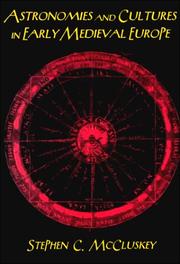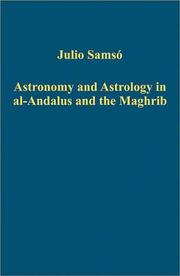| Listing 1 - 10 of 33 | << page >> |
Sort by
|

ISBN: 0521778522 Year: 2000 Publisher: Cambridge Cambridge University press
Abstract | Keywords | Export | Availability | Bookmark
 Loading...
Loading...Choose an application
- Reference Manager
- EndNote
- RefWorks (Direct export to RefWorks)
Astronomy, Medieval. --- Astronomy --- Astronomie médiévale --- Astronomie --- History. --- Histoire

ISBN: 9780754659341 0754659348 Year: 2007 Volume: CS887 Publisher: Aldershot Burlington Ashgate
Abstract | Keywords | Export | Availability | Bookmark
 Loading...
Loading...Choose an application
- Reference Manager
- EndNote
- RefWorks (Direct export to RefWorks)
Astronomy, Medieval --- Astrology --- Astronomie médiévale --- Astrologie --- History --- Sources. --- Histoire --- Sources --- Astronomie médiévale
Book
ISBN: 9789004436565 9004436561 9004436588 9789004436589 Year: 2020 Publisher: Leiden, The Netherlands ; Boston : Brill,
Abstract | Keywords | Export | Availability | Bookmark
 Loading...
Loading...Choose an application
- Reference Manager
- EndNote
- RefWorks (Direct export to RefWorks)
"In On Both Sides of the Strait of Gibraltar Julio Samsó studies the history of medieval astronomy in al-Andalus (Muslim Spain), the Maghrib and the Christian kingdoms of the Iberian Peninsula. He proves that the Arabic, Latin, Hebrew, Castilian and Catalan sources belong to the same tradition whose origin can be dated in the 11th century due to the changes in Ptolemy's astronomical theory introduced by the Toledan astronomer Ibn al-Zarqālluh/Azarquiel. The book also analyses the role of al-Andalus and the Iberian Peninsula in the transmission of Islamic astronomy to Europe and justifies the fact that Eastern Islamic works published after ca. 950 CE were not accessible to medieval European scholars because they had not reached al-Andalus"--
Astronomy, Medieval --- Astronomy --- Astronomy, Medieval. --- History. --- Medieval astronomy --- Astronomie médiévale
Book
ISBN: 9789811246227 9789811245497 Year: 2022 Publisher: Hackensack, NJ : World Scientific,
Abstract | Keywords | Export | Availability | Bookmark
 Loading...
Loading...Choose an application
- Reference Manager
- EndNote
- RefWorks (Direct export to RefWorks)
"The Divine Comedy" by Dante Alighieri is the story of a journey across the Universe as it was known in the Middle Ages, a work of science fiction ante litteram. Dante had an encyclopedic mind, no doubt, and his poem is the most widely read book after the Bible. He was a master of the astronomical knowledge of his time, and used astronomy in his work to indicate places, to measure time, and to exemplify beauty. Indeed, in the Convivio, he wrote that science is "the ultimate perfection of our soul" and "astronomy - more than any other science - is noble and high for a noble and high subject." We propose a reading of the Divine Comedy through astronomy with a journey starting from the Earth, proceeding to the Moon, the planets, and to the outermost edges of the Universe. The way in which Dante connects ancient astronomy with modern conceptions of the cosmos will astonish readers more than 700 years later.
Astronomy, Medieval. --- Astronomy, Medieval, in literature. --- Cosmography in literature. --- Astronomie médiévale --- Astronomie médiévale --- Cosmographie --- Dans la littérature --- Dante Alighieri, --- Dante Alighieri, --- Dante Alighieri --- Dante Alighieri --- Knowledge and learning.
Book
ISBN: 9782410011418 2410011411 Year: 2018 Publisher: Paris Belin
Abstract | Keywords | Export | Availability | Bookmark
 Loading...
Loading...Choose an application
- Reference Manager
- EndNote
- RefWorks (Direct export to RefWorks)
Quelle que soit la civilisation à laquelle il appartient - aborigène, grecque, égyptienne, arabe, chinoise, maya, etc. -, l'être humain cherche dans le ciel des réponses aux questions qu'il se pose sur son origine, son avenir et sa finalité. Ainsi, l'astronomie a commencé à travers les mythes célestes imaginés par les Anciens pour expliquer l'ordre du monde, et la place qu'ils y occupaient.Dans ce livre, l'auteur mène une passionnante enquête à travers le monde sur les astronomies anciennes, de Stonehenge à Gizeh en passant par Pékin et Mexico. Les savoirs astronomiques passés étaient loin d'être négligeables, et certainement pas limités aux seuls travaux des Grecs. Les tablettes mésopotamiennes, les annales chinoises et les chroniques médiévales sont en outre d'une singulière utilité pour les astronomes modernes : comment sinon remonter aux variations de la durée du jour au cours des siècles, ou percer la nature de l'explosion qui a frappé tant d'observateurs en 1054 ?Ce livre offre ainsi un voyage magnifiquement illustré à travers les âges, entre astronomie et archéologie. Avec passion, l'auteur raconte les toutes dernières avancées et les découvertes récentes du domaine. Angkor Vat, Pétra, l'Île de Pâques, les lignes de Nazca, le Machu Picchu ... ces monuments mythiques et leur contenu astronomique n'auront plus de secrets pour vous !
Astronomy --- Cosmology, Ancient. --- Astronomy, Ancient. --- Astronomie --- Cosmologie antique. --- Astronomie antique. --- Astronomie médiévale. --- History --- Histoire --- Histoire. --- Astronomie médiévale.
Book
Year: 1968 Volume: Nouv. ser., 7 Publisher: Brussel : Paleis der Academiën,
Abstract | Keywords | Export | Availability | Bookmark
 Loading...
Loading...Choose an application
- Reference Manager
- EndNote
- RefWorks (Direct export to RefWorks)
Astronomy, Medieval --- Natural history --- Astronomie médiévale --- Sciences naturelles --- Pre-Linnean works --- Ouvrages prélinnéens
Book
ISBN: 9781781382943 9781781382936 178138293X 1781382948 Year: 2016 Publisher: Liverpool : Liverpool university press,
Abstract | Keywords | Export | Availability | Bookmark
 Loading...
Loading...Choose an application
- Reference Manager
- EndNote
- RefWorks (Direct export to RefWorks)
Cosmology --- Astronomy, Medieval --- Time --- Cosmologie --- Astronomie médiévale --- Temps --- Early works to 1800. --- Ouvrages avant 1800 --- Isidore, --- Astronomie médiévale --- Cosmogonie antique --- Sciences naturelles
Book
ISBN: 8400072243 Year: 1993 Volume: 13 Publisher: Madrid Consejo superior de investigaciones científicas
Abstract | Keywords | Export | Availability | Bookmark
 Loading...
Loading...Choose an application
- Reference Manager
- EndNote
- RefWorks (Direct export to RefWorks)
Astrolabes --- Astronomy, Medieval --- Astronomie médiévale --- Early works to 1800 --- Ouvrages avant 1800 --- -Astronomy, Medieval --- Medieval astronomy --- Astronomical instruments --- Astronomie médiévale
Book
ISBN: 2251450356 9782251420356 9782251420349 2251420347 2251420355 Year: 2008 Volume: 7 Publisher: Paris : Belles Lettres,
Abstract | Keywords | Export | Availability | Bookmark
 Loading...
Loading...Choose an application
- Reference Manager
- EndNote
- RefWorks (Direct export to RefWorks)
Deuxième partie du Monde des sphères, La Fin du cosmos classique a pour objet la mort des sphères célestes, dont la naissance et la vie ont été étudiées dans le premier tome. Les orbes porteurs des planètes ont été les premiers à disparaître de la machinerie du ciel, lorsque leur existence s'est trouvée contredite par une série de phénomènes célestes spectaculaires. L'étude du débat passionné qui mit aux prises les meilleurs astronomes, dans le dernier quart du XVIe siècle, est l'occasion d'un réexamen du rôle central que l'historiographie a prêté jusqu'ici à Tycho Brahe. La sphère des fixes, elle, a résisté plus longtemps. Bien que théoriquement sans nécessité dans les systèmes prônant la mobilité de la terre, certains auteurs l'ont conservée parce qu'elle leur permettait de penser encore le monde comme totalité une et ordonnée. En ce sens, Copernic et Kepler sont restés fidèles à la figure idéale du cosmos héritée des Grecs. En revanche, Bruno, Gilbert, Galilée et Descartes, pour d'autres raisons philosophiques ou théologiques, n'ont pas hésité à faire éclater l'enveloppe protectrice du monde, et à affronter en pensée un univers immense, sans forme ni limite, expression nécessaire, ou seulement probable, de la puissance infinie de Dieu.
Cosmography. --- Cosmology. --- Cosmologie --- Cosmologie antique --- Astronomie médiévale --- Astronomie de la Renaissance --- Astronomie --- Astronomie grecque --- Astronomie antique --- Globes célestes --- Cosmographie --- Histoire --- Philosophie --- 17e siècle
Book
ISBN: 9780192844149 0192844148 Year: 2022 Publisher: Oxford Oxford University Press
Abstract | Keywords | Export | Availability | Bookmark
 Loading...
Loading...Choose an application
- Reference Manager
- EndNote
- RefWorks (Direct export to RefWorks)
This volume makes available a newly discovered work by the Swabian astronomer Heinrich Selder (fl.1365-79), a hitherto overlooked figure in fourteenth-century intellectual history. Composed from 1371 to at least 1379, this "Treatise on the Time of the Lord's Annunciation, Nativity and Passion" (Tractatus de tempore dominice annunciationis, nativitatis et passionis), records Selder's surprising views on two seemingly unrelated questions: the dimensions of history and the folly of astrology. Drawing on a diverse range of sources, from ancient Roman poets to the writings of a twelfth-century mystic nun, his 'Treatise' documents a sophisticated and prescient attempt to reconstruct the chronology of early human history, from the creation of the world to the birth of Christ, in a scientifically sound manner. Woven into these discussions is a fierce attack on the rationality and legitimacy of judicial astrology, which spotlights Selder as one of the most radical critics of this art and its practitioners in fourteenth-century Europe. "A Fourteenth-Century Chronologer and Critic of Astrology" presents the treatise in a critical edition with facing English translation. It is prefaced by a detailed investigation into its authorship and context as well as by in-depth analyses of its specific contributions in the areas of medieval astronomy, chronology, and anti-astrological thought.
Astronomy, Medieval. --- Astronomy. --- Astronomie médiévale. --- Astronomie. --- Esoteric sciences --- Medieval Latin literature --- History of civilization --- History of Europe --- anno 1300-1399 --- Astronomie médiévale.
| Listing 1 - 10 of 33 | << page >> |
Sort by
|

 Search
Search Feedback
Feedback About UniCat
About UniCat  Help
Help News
News